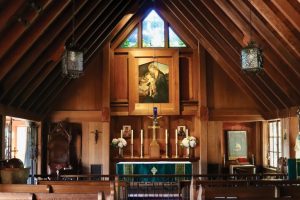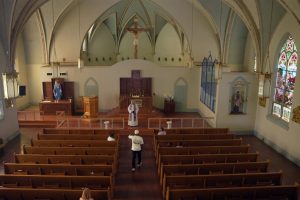It has long been argued that laypeople should be able to share their expertise through preaching during the homily at Mass. Despite these urgings, church teaching on the subject is not entirely open to interpretation: Canon law states, “Among the forms of preaching, the homily, which is part of the liturgy itself and is reserved to a priest or deacon, is pre-eminent.”
This doctrine, however, has not stopped the Roman Catholic Diocese of Rochester, New York from allowing laypeople to preach following the Gospel reading. From the mid-1970s, the diocese—which has earned a reputation for being among the most liberal in the country under the guidance of Bishop Matthew Clark—has allowed both men and women to take the pulpit on Sundays. Skirting the issues with canon law, lay homilists have carefully described their preaching as a “reflection” on scripture. A switch in leadership to Bishop Salvatore Matano is causing the diocese to rethink the situation and ultimately stop it.
Nancy DeRycke, the pastoral associate at Our Lady of Lourdes and St. Anne Church in Brighton, told the Star Gazette, “It’s a 40-year-old custom that’s been part of the tradition of our local church, and people are saddened, people are frustrated and people are asking, ‘Why can’t you do this?’ “They’re not satisfied with saying, ‘Because it’s the law.’ ”
These frustrations bring us to the usual suspects of arguments for letting laypeople preach. Some people feel that not all priests are gifted homilists and they would get more out of the Mass if a priest was to step aside and allow a layperson to tackle a topic. Others say that lay preachers would be a way women could contribute directly to the Mass. Still others claim that priests—as celibate and male—are missing the mark when it comes to connecting with their parishioners regarding topics like marriage and family life.
In our March 2013 Sounding Board survey, religious educator Karen Dix argued that laypersons should have the opportunity to give the homily. This would save the priest—though not needed for all cases—from lackluster homilies due to time constraints, lack of expertise on a subject, and general disinterest in giving the homily.
Dix refers to the 2001 complementary legislation to canon law by the United States Conference of Catholic Bishops where they made an exception for lay preaching in other settings. “If necessity requires it in certain circumstances or it seems useful in particular cases,” the bishops wrote, “the diocesan bishop can admit lay faithful to preach, to offer spiritual conferences or give instructions in churches, oratories or other sacred places within his diocese, when he judges it to be to the spiritual advantage of the faithful.”
“If the bishops have already recognized the value of lay preaching (in other events outside of the Mass), why not take the extra step of allowing laypeople to give the homily?” Dix says.
Seventy-two percent of those surveyed said that they’d love to hear a layperson give a homily. But this custom in Diocese of Rochester has halted lay preachers from sharing their faith with congregations after almost 40 years leaving many like DeRycke devastated. Should the church be more flexible regarding the homily in the future and examine the lay homilists on a case-by-case basis? Or should homilies be reserved for priests and deacons?











